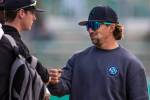Music therapy helps those with disabilities to heal and socialize



Music has been known to fill the void when words fail, express the heart’s desires and silence the mind. It can be heard in every culture and understood in any language. Though artistic in nature, recent years have proved the emotional and physical healing effects it can have on people.
In 2009, a bell choir formed at the Blind Center of Nevada, 1001 N. Bruce St., using the technology of ARBECY, the brainchild of choir director Jerry Simon, a music therapist major.
“What really turned me over to music therapy was when I was in the 11th grade and just finished playing a community concert,” Simon said. “This little girl who was (mentally ill) ran up to me and gave me a hug. All she knew was that music made her happy. It touched my heart in a whole different way.”
ARBECY, which stands for R, B, C meaning remote-controlled bell choir, works by catching each note and sending a wireless notification to a modified cellphone held by a person who is waiting to play the note.
With the soft and vibrant music that fills the auditorium at the center, choir members are able to relax and rejoice after successfully playing classical songs.
“Everyone is able to perform something beautiful,” Simon said. “That’s what ARBECY is. It’s synergy. Music is very healthy.”
The bell choir consists of 13 members, most of whom are blind with the exception of volunteer-member Amy Klene, who suffers from traumatic brain injury.
“After the car accident, Amy couldn’t speak,” said her mother Julie Klene. “She required round-the-clock care. She couldn’t even swallow. Now, 12 years later, she’s walking and has improved her speech and computer communication skills.”
Klene’s physical therapist, Jana Sutter of Integrity Health & Wellness, has also noticed significant changes in her progress.
Sutter said it is common with traumatic brain injury patients to see a “stair-step” effect pertaining to progress and recovery. She believes the vibrations from the bells have played a large role in Klene’s development.
“Like a pebble thrown into a pond, the ripples and vibrations of (music therapy) are far reaching,” Sutter said. “In the past six months, I have noticed considerable gains and changes both physically, cognitively and emotionally. I have seen the greatest gains pertaining to sensory integration and her ability to read her body from a physical awareness perspective (Kinesthetic Awareness).”
Besides the soothing effects of music, perhaps the most beneficial aspect of the bell choir has been the social interaction and the boost in confidence that has formed between members.
“The bell choir became my first social group since I moved to Las Vegas,” said choir member Veatrice Lucas. “It’s not only emotionally satisfying, but it has boosted our confidence. Before, I would never venture out on my own. Now I realize that I can be a part of the world. I don’t have to stay at home and be depressed. A group of us have gone out to eat lunch and to a bar. Going to a club is next on our list.”
Simon was inspired to design the ARBECY in 1977 after graduating with a bachelor’s degree in music therapy from Loyola University in New Orleans. He did his post-graduate internship at Pinecrest State School in Louisiana and led a group of mentally challenged youths in bell choir by using hand signals.
“Autistic children seem like they avoid contact with other humans,” Simon said. “They won’t respond to what’s happening around them. When you play music, they’ll look directly at you. It’s like something magical that’s happening.”
The study of music therapy has grown in recent years.
After Congresswoman Gabby Giffords was shot in the head in 2011, she dealt with mental and physical limitations from the injury. Yet, a month ago, Giffords posted a video of herself sharing a duet from the musical “Annie” with a music therapist at TIRR Memorial Hermann Rehabilitation and Research Hospital in Houston.
Music therapy has been scientifically and medically proven to be a valuable tool in rehabilitation after a stroke.
The particular areas of benefit have been found in movement and muscle control, speech and communication, cognition, and mood and motivation, according to the American Stroke Association’s website, strokeassociation.org.
For these reasons and more, stroke support group leader Lori Wright partners with Simon to help stroke survivors at Desert Springs, Valley and St. Rose Siena hospitals.
“Everyone enjoys music in one form or another; it’s a healing source,” Wright said. “Using the ARBECY bells was great because some of us have become paralyzed in one side of our body. This was cool because we only need to use one hand to play the bells.”
From the Blind Center to hospitals, mental health facilities and even hospice programs, music therapy has proven useful in many aspects of life.
“The bell choir has helped me with releasing my stress and keeps us positive,” said choir member Walter Argueta. “It takes my mind somewhere else, out of the darkness.”
For more information about ARBECY, visit arbecy.com. For more information about the bell choir, visit blindcenter.org.
To reach North View reporter Sandy Lopez, email slopez@viewnews.com or call 702-383-4686. Find her on Twitter: @JournalismSandy.


















